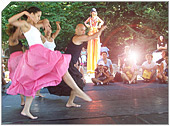Bay Ridge, Brooklyn, New York City
|
Getting Started
Index
NYC Neighborhoods
Manhattan
Brooklyn
Queens
Bronx
Staten Island
NYC Icons
Chrysler Building
Flatiron Building
Empire State Building
Safe NYC
NYPD
FDNY
NYC Weather
NYC Climate
NYC Weather Forecast
Winter Season
Spring Season
Summer Season
Fall Season
NYC History & Politics
New York City History
Tammany Hall and Politics
New York City Politicians
New York City Personalities
Culture of Gotham City
Culture of the city
Cultural diversity
City in popular culture
|
Bay Ridge is a neighborhood in the southwest corner of the New York City borough of Brooklyn, USA. It is bound by 65th Street on the north, Interstate 278 on the east, and the Belt Parkway-Shore Road on the west. The southern border is 101st Street. The portion below 86th Street is a subsection called Fort Hamilton. A small area east of I-278, bounded by 7th Avenue, is also part of Bay Ridge.
History
Bay Ridge was originally known as Yellow Hook, for the yellowish soil the original Dutch settlers observed. This name was changed in the 1790's after yellow fever struck the area and residents realized what an ill fit it was given the circumstances. The new name was given due to the proximity of the neighborhood to New York Bay, excellent views of which were visible from the ridge that has now become Ridge Boulevard. These views attracted wealthy people, who built extravagant summer homes along Shore Road overlooking the water, many of which are still standing today and worth well over one million dollars. Once the 4th Avenue Subway (now the R line) was extended in 1915, however, many Manhattan workers looking for quieter surroundings began to flow in, transforming the area into a middle-class neighborhood.
During the nineteenth and early-twentieth centuries, many Norwegian and Danish sailors emigrated to Brooklyn, many specifically to Bay Ridge. Nordic heritage is still apparent in some sections of the neighborhood. For instance, there is an annual Norwegian Constitution Day Parade [2] featuring hundreds of people in folk dress who parade along Fifth Avenues, ending in Leif Ericson Park where "Miss Norway" is crowned at the statue of Ericson donated by the Prince of Norway in 1939.
Construction of The Verrazano Bridge was completed in 1964. Though now a totemic structure beloved by many, it was bitterly opposed by residents upon the announcement of its construction, for it would require the demolition of many homes. In a rare loss for local activists, the challenges failed: the bridge was built and the homes destroyed. Also destroyed was Fort Lafayette, part of New York City's defense system along with Fort Hamilton and Fort Wadsworth in Staten Island, replaced by the base of the bridge's east tower.
The Farrell House, which has been at 125 95th St. since the early twentieth century, is one of many old mansions in Bay Ridge, and is now an official landmark. An accompanying structure, thought to have been used as a barn, was unable to be saved and was demolished. Legend has it the house was turned so that its "widow's walk", a balcony that traditionally faces the sea so women left at home could watch for their husbands' ships, would no longer face The Narrows.
The area of the neighborhood around Ovington Avenue (aka 70th Street) was once known as "Ovington Village"; it was ultimately swallowed up as Bay Ridge.
|
New York City Search
Quick NYC
|
|
|
 How safe is New York City?
How safe is New York City? Contrary to popular belief, the City consistantly ranks in the top ten safest large cities in the United States. The NYPD is the largest municipal police force in the world and has it's own Movie/TV Unit. |

New York has a humid continental climate resulting from prevailing wind patterns that bring cool air from the interior of the North American continent. New York winters are typically cold with moderate snowfall.  New York Weather Forecast New York Weather Forecast |

New York's two key demographic features are its density and diversity. The New York City metropolitan area is home to the largest Jewish community outside Israel. It is also home to nearly a quarter of the nation's South Asians, and the largest African American community of any city in the country.  Ethnic composition Ethnic composition |

New York Newspapers
 
|



 New York Weather Forecast
New York Weather Forecast
 Ethnic composition
Ethnic composition


















